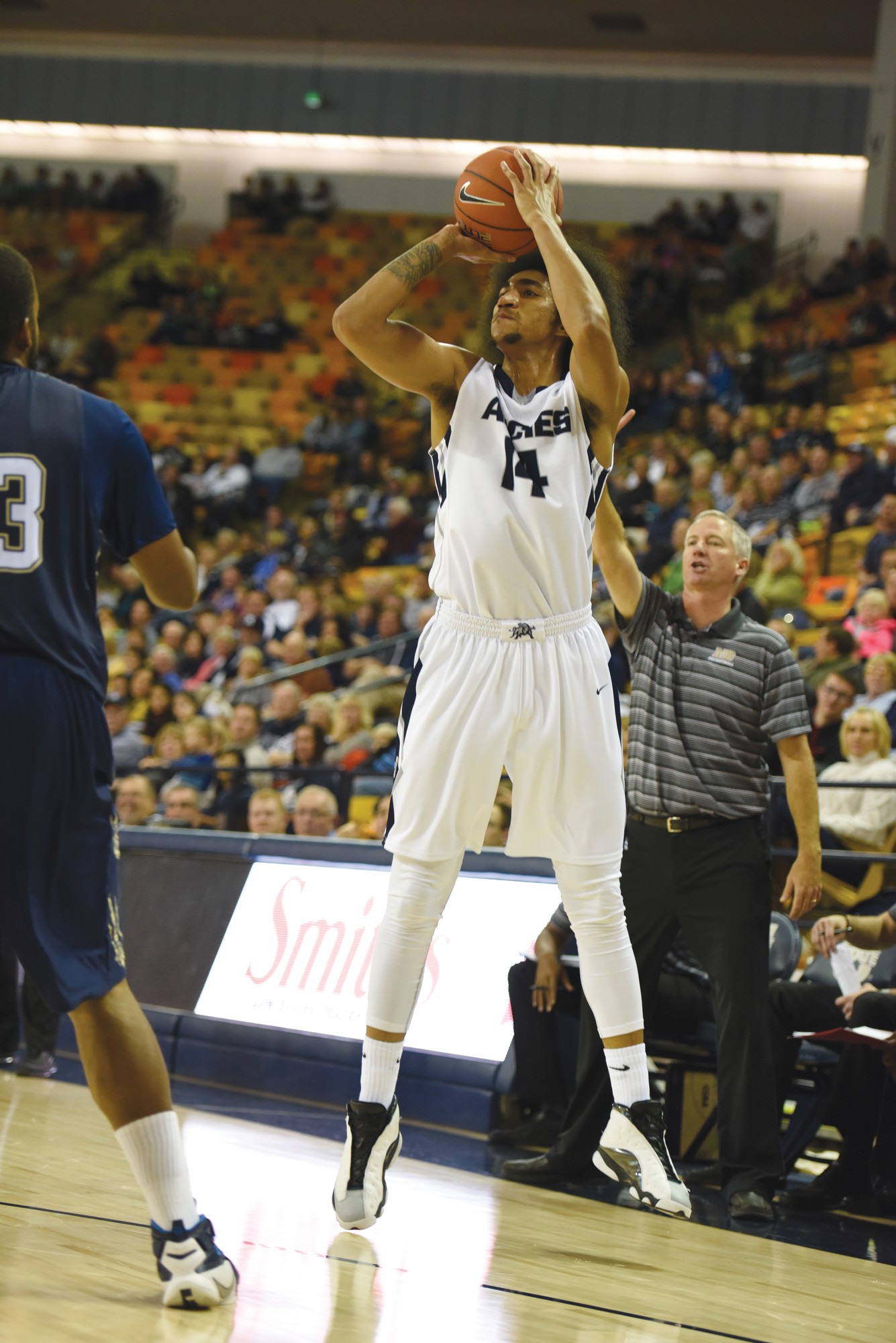The advantage of the 3-point shot
Facing Air Force on Jan. 17, 2015, the Utah State men’s basketball team held a 28-21 lead over the visitors.
Head coach Stew Morrill called a timeout with six seconds left and drew up a play intended to get a quick post look. Point guard Darius Perkins received the ball, but a quick trap took away the inside look he wanted. He instead swung the ball to guard Chris Smith, who buried a contested 3-pointer over two defenders, sending the Spectrum crowd into a frenzy.
“It feels good because you throw it up in the air and everybody goes crazy,” Smith said. “Especially in the Spectrum, it gets nuts in here. It’s a great feeling in this place.”
It was one of 13 3-pointers the Aggies hit against the Falcons that game. USU attempted a whopping 591 last season, good for second in the conference.
Smith, now a senior, led the Aggies in 3-point shooting last year, hitting 63-133 for 47 percent on the season. He was one of three players to make 45 or more 3’s and hit 39 percent or more of them, including senior guard Darius Perkins and junior wing Jalen Moore. Sophomore Julion Pearre also made 36-105 from deep, giving USU a quartet of capable shooters.
The ability to shoot from deep does three things for an offense: It creates space for the big men to operate under the basket, it creates seams for playmaking guards to drive to the basket and it punishes defenses that give too much space to the shooters.
“If you don’t have anybody who can shoot, then everybody can just sit in the lane,” said Chris Jones, in his eighth season as an assistant coach at USU. “It’s hard to get the ball into the post and it’s hard to get the ball penetrated.”
The coaching staff at Utah State has focused on bringing in players who can create space and take advantage of it.
“Our priority is to have multi-skilled guards and forwards that can shoot 3’s and can also drive the ball,” Jones said. “We have the ability to score in the paint in two ways: the post feed and via penetration.”
Creating shots at the rim is critical to Utah State’s success.
“We’ve always been an inside-out program,” Jones said. “Coach Morrill was always that way and Coach Duryea will be the exact same way.”
Jerry Finkbeiner, the head coach of the women’s basketball team, researched the most effective plays on a basketball court. He found that, in terms of average points per play, 3-point shots were just a step below shots at the rim and were significantly higher than mid-range shots.
“We want all in the red zone and all behind the 3,” Finkbeiner said, referring the area within 10 feet of the hoop. “We don’t want to take anything in the mid-range.”
The ability to shoot from deep and to score in the paint work together, putting the defense in uncomfortable positions and creating opportunities for the offense. Neither the men’s nor women’s coaches runs many set plays; rather, they focus on teaching concepts and letting the athletes on the floor make plays.
“It’s not really sets, it’s more concept and more situation-oriented,” Jones said. “We want to have basically four players on the perimeter — spaced out beyond the NBA 3 — and they are taught to cut, space and move, which opens up the floor for driving lanes.”
Finkbeiner agreed, pointing to the “Aggie offense” his team runs.
“It’s spread; There’s a lot of gaps,” Finkbeiner said. “If there’s any kind of help side [defense] or a collapse then we dish out for 3. If there’s no 3 then we drive to the basket and if it collapses then she’ll dish out for another 3. If it’s a wide open 3, we’ll take it. If not, she’ll drive.”
“In simplicity,” Finkbeiner explained, “it’s all about driving to the hole and if it collapses, dish out for a three.”
The player movement and the passing creates a swirling effect, leaving defenders to chase the ball and the players until the offense gets a shot that it likes. It’s a nightmare situation for a defense.
The success of the offense, though, hinges on the threat of 3-point shooting.
“The only way to space the floor is, you’ve got to have guys who can shoot,” Jones said.
— thomas.sorenson@aggiemail.usu.edu
Twitter: @tomcat340

